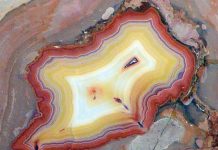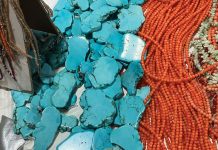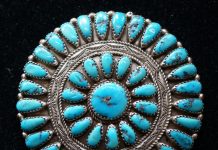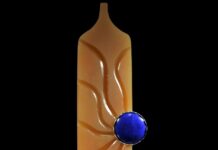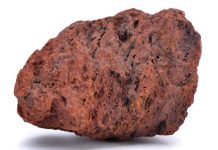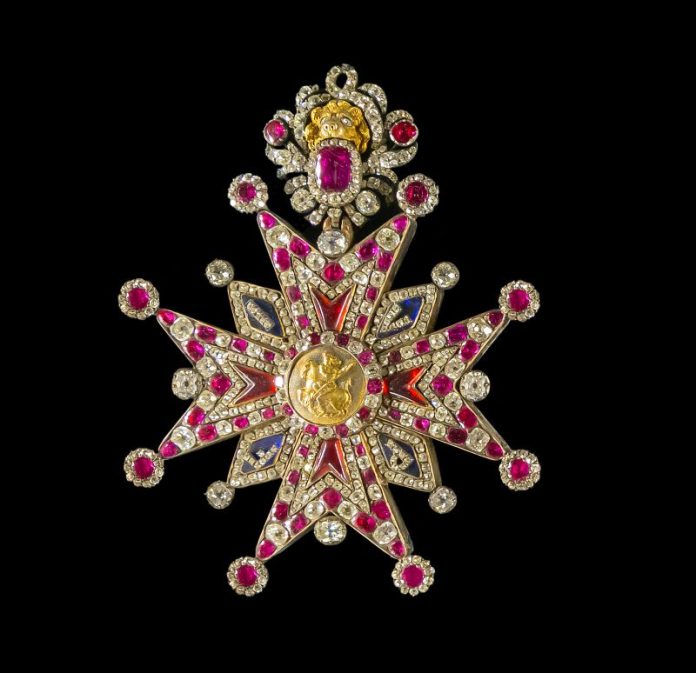
Few words are as packed with meaning as “ruby.” While the word refers primarily to the natural ruby, it is also the preferred adjective for red colors of extraordinary intensity and purity. Its association with wealth and royalty conjures romantic images of kingdoms that once flourished in such historical ruby sources as Ceylon, Siam, Burma and India.
And Ruby continues to attract attention today. In June 2023, Sotheby’s, the New York City-based international auction house, auctioned off the largest transparent, gem-quality ruby ever faceted. The stunning, 55.22-carat, cushion-cut Estrela de FURA (Star of FURA) sold for $34.8 million ($630,288 per carat), a record for a colored gem. This spectacular ruby is notable not only for its size and beauty but also for its origin—a newly discovered, major deposit in the East African nation of Mozambique.
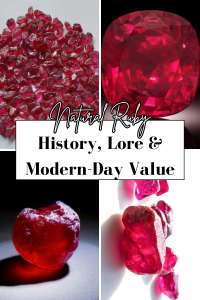
How Natural Ruby Forms: Red Corundum Explained
Ruby is a color variety of the mineral corundum or aluminum oxide. As an allochromatic (other-colored) mineral, corundum’s colors vary because of the presence of nonessential, color-causing agents called chromophores. Pure corundum is colorless. Red corundum is ruby; all other colors (including colorless) are sapphire. Ruby’s diagnostic red color is caused by traces of trivalent chromium, which absorb the non-red wavelengths of white light and reflect only the red wavelengths.
Most ruby occurs in metamorphic rocks. Aſter weathering free from their host rocks, corundum gemstones are sufficiently dense (specific gravity 3.9-4.1) to form secondary alluvial concentrations (placer deposits) that may be of economic importance.
Transparency and color determine ruby value. The most desirable color is “pigeon’s blood,” an intense, pure red devoid of any bluish hint. Natural rubies always exhibit some color zoning and inclusions of tiny rutile needles. In sufficient quantity, the latter creates both a soſt translucency known as “silk” and occasionally the asterism effect of star rubies.
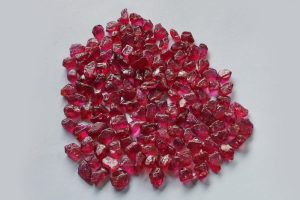
FURA Gems
The Natural Ruby in Legend and Spiritual Lore
With its great hardness (Mohs scale of hardness – 9.0), durability, relatively high index of refraction (1.77) and vibrant red color, ruby has served as a precious gemstone since antiquity. Archaeological evidence from Neolithic sites in Myanmar (formerly Burma) suggests that ruby mining began as early as 8000 B.C. By 200 B.C., rubies were being traded regularly along the Silk Road linking China with the Middle East.
Hindus knew ruby as ratnaraj, literally “the king of precious stones.” Oriental legends describe ruby as the “spark of life” and “a drop of blood from the heart of Mother Earth.” Early Burmese cultures believed that rubies “ripened” with age and that sapphires were “unripe” rubies, while silky rubies were “overripe.”
During the Middle Ages, rubies were thought to promote good health and guard against wicked thoughts. Medieval physicians associated ruby with blood and treated heart ailments with potions of powdered ruby.
According to modern metaphysical practitioners, ruby enhances love, spirituality, creativity, and wisdom, imparts confidence and courage, and stimulates leadership abilities. Ruby is the birthstone for July and the gem for the 40th wedding anniversary. Star ruby is the gem for the 52nd wedding anniversary.
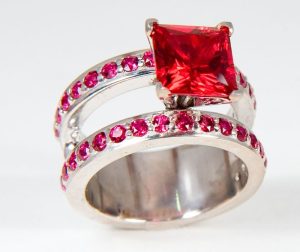
Wikimedia Commons
Synthetic vs. Natural Ruby
Throughout much of history, ruby referred to any red gemstone, especially pyrope garnet and the red variety of spinel. It gained a specific gemological definition only after 1800 when mineralogists recognized corundum as aluminum oxide and ruby as a color variety.
In the 19th-century United States, the enduring belief that all red gemstones were “rubies” inspired many place names like “Ruby Mountain,” “Ruby Hill,” and “Ruby Creek” that were based on garnet occurrences.
Many magnificent red spinel gems have historically been labeled as “ruby,” most notably the Black Prince’s Ruby, the 170-carat, irregular cabochon now set into the Imperial State Crown of the United Kingdom.
Ruby was also the first precious gemstone to be synthesized. In the 1890s, French chemist Auguste Verneuil’s flame-fusion process crystallized a molten mix of aluminum and chromium oxides to create transparent, gem-quality, synthetic rubies identical in appearance to natural stones but far less costly. Translucent, synthetic star rubies cut as cabochons later became popular, while synthetic transparent rubies continue to be faceted for millions of high school and college graduation rings each year.
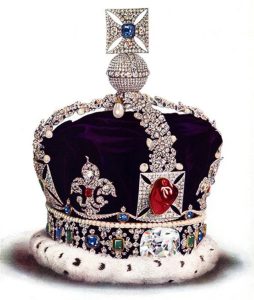
Wikimedia Commons
Modern Sources of Natural Ruby: Mozambique’s Rise
The present-day nations of Myanmar, Sri Lanka (formerly Ceylon) and Thailand (formerly Siam) have traditionally provided most facet-grade rubies, with the best being the pigeon’s-blood stones from Myanmar’s Mogok District, a standard now being challenged by stones from Mozambique.
Gem-quality rubies were discovered in 2009 near the northern Mozambique city of Montepuez in metamorphic amphibolite that had largely weathered into gravel. The presence of rubies in unconsolidated gravel initially attracted thousands of unlicensed, artisanal miners equipped only with shovels.
In 2014, a government corporation partnered with a British gem-mining company to evict the artisanal miners and begin organized mining. Its impressive revenues of $125 million in just three years attracted the attention of FURA, a well-funded, Dubai-based, upstart gem-mining company that acquired the mining leases in 2017. FURA’s700 workers now process 600 tons of gravel per hour at the world’s first industrial-scale ruby mine, which recovers ten million carats of ruby per year—half the world’s annual
production.
The Estrela de FURA, the cushion-cut, a 55.22-carat ruby gem that recently sold for a record $34.8 million, may just be the beginning. Experts expect even larger stones to be found there as Mozambique writes the next chapter in the long, romantic history of ruby.
FAQ: Natural RubyWhat is a natural ruby?A natural ruby is a red variety of the mineral corundum formed under intense heat and pressure in the Earth. Its vibrant red color comes from trace amounts of chromium. Where do natural rubies come from?Natural rubies are found in metamorphic rock formations in countries like Myanmar, Thailand, Sri Lanka, and most recently, Mozambique, which is now a major global source. What is the difference between natural and synthetic ruby?Natural rubies form over millions of years in the Earth, while synthetic rubies are lab-created using similar chemical compositions. Natural rubies are more valuable and rare. Why are some natural rubies so expensive?Price depends on color (especially “pigeon’s blood” red), clarity, size, and origin. The finest natural rubies, such as those from Mogok or Montepuez, command premium prices. How can you tell if a ruby is natural?Gemological testing by a certified lab can determine whether a ruby is natural or synthetic. Inclusions, growth patterns, and trace elements offer important identification clues. |
Final Thoughts
The natural ruby has inspired awe for thousands of years, symbolizing strength, love, and vitality across cultures. From ancient Burmese mines to modern discoveries in Mozambique, natural ruby continues to captivate with its rich color, rarity, and resilience. Whether viewed as a treasure of geology or a symbol of the heart, the natural ruby remains one of the world’s most iconic and meaningful gemstones.
This article previously appeared in Rock & Gem magazine. Click here to subscribe. Story by Steve Voynick.


